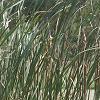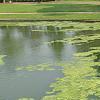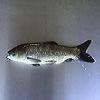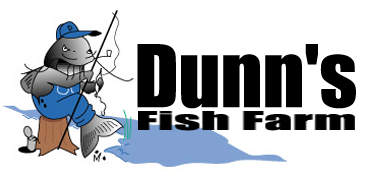 |
 |
|
February 10th, 2005
|
POND & LAKE MANAGEMENT
Aquatic Weed Control
Contributed by,
Kelly Duffy, Houston, TX
|
| |
Greetings!
A pondmeister's relationship with aquatic
vegetation
might easily be compared to his relationship with
kids. With kids, he can probably tolerate a few of
the two-legged critters within his domain, and may
actually welcome them - so long as they're well
behaved. However, when an unruly brat arrives at
the door, or when his house becomes a little
over-crowded, his attitude toward the invaders may
abruptly change.
So it is with aquatic vegetation. Certain types and
amounts of aquatic vegetation normally present few
headaches and may actually enhance a pond-owner's
efforts. However, when particularly nasty plant
species invade his pond or when
low-density "vegetation" rapidly mutates into
high-density "weeds," the increasingly irritable
pondmeister will sometimes consider napalm and
nuclear devices as potential cures for the problem.
One of the greatest challenges that many
pond-owners will face is the task of managing aquatic
vegetation to an acceptable level without negatively
impacting the pond's aesthetic and recreational value.
A detailed book on the full spectrum of aquatic
vegetation management methods (if it exists) could
easily occupy several inches of bookshelf. It is
difficult to present a generic, yet comprehensive
vegetation management program due to the matrix of
dynamic variables that occur from pond-to-pond and
season-to-season. Therefore, this article will stick
to the author's concept of the ten basic "rules of
engagement" for aquatic vegetation
management.
|
|
 |
Rules Of Engagement Part I |
|
|
Click image for cattail control
|
|
Common Cattails

- Vegetation Management (VM) Rule #1:
The
pond's design and construction should limit the
amount of shallow perimeter water to a level that will
adequately support spawning and livestock
requirements. Excessive amounts of shallow
water
will simply increase the primary habitat in which
weeds and algae gain their foothold.
- VM Rule #2: "Clear water" is a weed
problem
waiting to happen. Consider the options for
decreasing sunlight penetration, such as a pond
fertilization program or a lake-dye. Pond
fertilization,
if properly administered, is preferred in most
situations because of its beneficial impact on fish
carrying capacity. Conversely, lake-dyes
may
negatively impact the pond's natural food chain.
Therefore, the use of lake-dyes is normally
discouraged in fishing ponds unless the food chain is
being supplemented in a significant manner.
- VM Rule #3: Proactively monitor
your
pond in
order to detect real or potential weed problems as
early in the season as possible. Be able to
identify
problematic species upon sight. Since many aquatic
plant and algae species have phenomenal
reproductive capabilities, the ability to identify these
species and initiate the appropriate early season
response is crucial to a successful management
program. (Note: Some of the largest forest fires
could have been extinguished with a bucket of water
had they been detected early on.)
- VM Rule #4: Evaluate, select and utilize
the
available vegetation management "tools" in a
cautious manner. Be sure that the
management
option under consideration is actually effective on
the targeted specie(s). As with power
tools, the
uses of vegetation management tools (i.e. grass
carp,
herbicides, algaecides) often pose certain degrees of
risk, particularly when they're improperly
deployed.
- VM Rule #5: NEVER use a herbicide
or
algaecide
in your pond that is not intended (labeled) for
aquatic-use. Too many times I've heard
people say
that they used "so and so" product (not labeled for
aquatic use) to kill algae or weeds because it was
cheap and it worked. Little do they realize the
long-term impact that their cheap remedy is having
on the
other organisms in the pond - including the fish.
Chemical manufacturers are not likely to overlook a
safe and profitable market for their products.
Therefore, if a chemical product isn't labeled
for
aquatic-use, you can rest assured that there is a
very good reason why the manufacturer did not
pursue such a use on the product's EPA
registration.
|
 |
Rules Of Engagement Part II |
|
|
Click picture for algae control
|
|
Filamentous Algae

- Vegetation Management (VM) Rule #6:
When
using aquatic
herbicides, be
sure to understand how they should be applied.
Using the correct product incorrectly will very likely
produce poor results. The leading cause of
most "product failures" is improper or inadequate
application technique and/or equipment.
- VM Rule #7: When using aquatic
herbicides, be
sure to apply them under the proper conditions.
Some products achieve optimum effectiveness
with a
springtime treatment while others require the warmer
temperatures of summer. Many products
should only
be applied under sunny conditions. Other products
should only be applied when rain is not expected for
several hours or when water levels are not expected
to fluctuate for several days or weeks.
- VM Rule #8: When using aquatic
herbicides,
avoid the common misperception that "If a little bit is
good, a lot is better!" You can only kill something so
dead. The labeled use-rates should
effectively
perform the job if the treatment is conducted
correctly. Over-treating a pond may create
serious
consequences for your fish and certainly for your
pocketbook.
- VM Rule #9: Don't waste your time
looking for a
one-shot "cure-all" chemical treatment for aquatic
weed problems. Aquatic weeds are similar to
roaches. You may significantly reduce their
population with a proper management program. But,
shy of draining the pond, it is unlikely that you can
prevent the reappearance of aquatic weeds
forever.
- VM Rule #10: If you're unwilling or
unable to take
the time to learn and implement a proper aquatic
vegetation management program, you may be better
off in the long run to hire a reputable lake
management company to tackle the challenge.
Because aquatic vegetation management is as much
an art as it is a science, an experienced commercial
lake management service may help you avoid
potentially serious problems down the road.
Understanding these basic "rules of engagement" is
the first step toward a successful aquatic vegetation
management program. Beyond this point, every pond
should have a vegetation management program
designed for its specific needs and circumstances.
Obviously, managing aquatic vegetation is not a small
or simple task. But the reward of a
navigable, "fishable" and aesthetically pleasing pond
is invaluable, and well worth the effort.
|
 |
A Note From Dunn's Fish Farm... |
|
|
Click image to learn more about grass carp
|
|
Biological Control

All of us at Dunn's Fish Farm hope you have enjoyed
the above article and find it beneficial. We
recommend you archive this email for future
reference. If there is a specific topic you would like
to see addressed in a future newsletter, please let us
know by responding to this email.
Let one of our Lake & Pond Management Specialist
develop a strategy to help manage your aquatic
vegetation problem now, before the growing
season starts. Call (800)433-2950 or respond to this
email. We look forward to serving you soon!
|
| |
 |
|
Contact Information
phone:
(800) 433-2950
|
|
|




